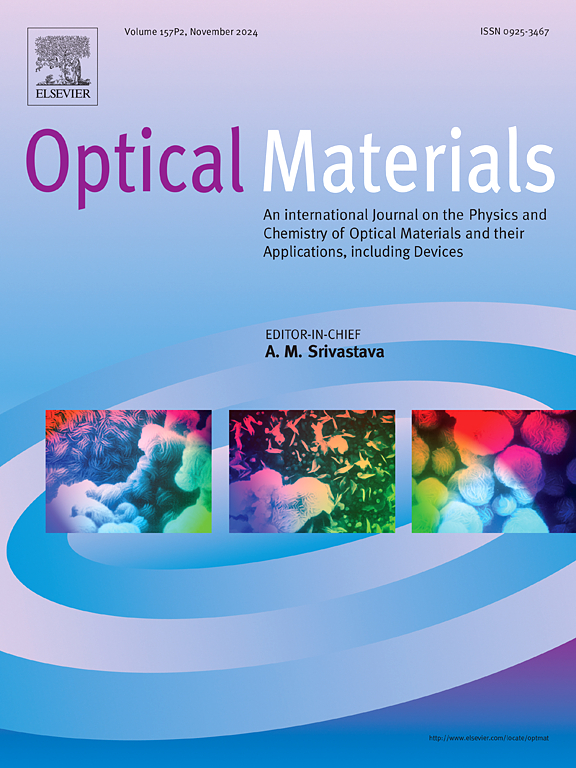蓝宝石衬底制备高质量ε-Ga2O3薄膜及太阳盲紫外探测器的氧流速优化
IF 3.8
3区 材料科学
Q2 MATERIALS SCIENCE, MULTIDISCIPLINARY
引用次数: 0
摘要
正交相ε-Ga2O3具有超宽的禁带,是制作高灵敏度太阳盲紫外探测器的关键材料。然而,纯相ε-Ga2O3的生长窗口窄,以及对氧流量和温度等生长参数的探索不明确,给制备高性能的太阳盲光电探测器带来了挑战。在本研究中,我们采用雾化学气相沉积技术(mist- cvd)在c平面蓝宝石衬底上制备了高质量的纯相ε-Ga2O3薄膜。在ε-Ga2O3薄膜上制备的金属-半导体-金属(MSM)日盲光电探测器具有优异的性能。首先,通过温度优化,发现在540°C ~ 640°C之间存在纯晶相窗,其中在580°C生长的薄膜具有最佳的结晶质量。随后,在580℃时,调节氧流量使(002)摆动曲线的半最大值全宽度(FWHM)从0.59°减小到0.46°,表明由于氧空位(Vo)的补偿,结晶度增加。ε-Ga2O3薄膜的均方根粗糙度(RMS)低至3.31 nm。在此基础上,制备了高性能的MSM日盲光电探测器,其暗电流低至2.11 × 10−11 a,响应率高达4.53 a /W,探测率为8.73 × 1013 Jones。本研究为氧流优化器件性能建立了一个系统框架,并提出了Vo机制来解释这一现象,为ε-Ga2O3薄膜的制备和实现高性能的太阳盲探测应用提供了有价值的见解。本文章由计算机程序翻译,如有差异,请以英文原文为准。

Optimization of oxygen flow rate toward high-quality ε-Ga2O3 thin films grown on sapphire substrates and solar-blind ultraviolet photodetectors
Orthorhombic phase ε-Ga2O3 is crucial for the fabrication of high-sensitivity solar-blind ultraviolet (UV) photodetectors due to its ultra-wide bandgap. However, the narrow growth window of pure-phase ε-Ga2O3 and unclear exploration of growth parameters, such as oxygen flow and temperature, make it challenging to prepare high-performance solar-blind photodetectors. In this study, we use mist chemical vapor deposition technique (mist-CVD) to fabricate high-quality pure-phase ε-Ga2O3 thin films on c-plane sapphire substrates. The metal-semiconductor-metal (MSM) solar-blind photodetectors fabricated on ε-Ga2O3 thin films exhibiting excellent performance. Firstly, temperature optimization revealed a pure crystalline phase window between 540 °C and 640 °C, with films grown at 580 °C exhibiting the best crystalline quality. Subsequently, at 580 °C, regulating the oxygen flow rate reduced the full width at half maximum (FWHM) of the (002) rocking curve from 0.59° to 0.46°, indicating increased crystallinity due to compensation of oxygen vacancies (Vo). The root-mean-square (RMS) roughness of the ε-Ga2O3 thin film is as low as 3.31 nm. Based on the optimized films, high-performance MSM solar-blind photodetectors were fabricated, exhibiting a dark current as low as 2.11 × 10−11 A, a responsivity as high as 4.53 A/W, and a detectivity of 8.73 × 1013 Jones. This work establishes a systematic framework for the oxygen flow optimization in devices performance and proposes a Vo mechanism to explain this phenomenon, providing valuable insights for fabricating ε-Ga2O3 thin films and achieving high-performance solar-blind detection applications.
求助全文
通过发布文献求助,成功后即可免费获取论文全文。
去求助
来源期刊

Optical Materials
工程技术-材料科学:综合
CiteScore
6.60
自引率
12.80%
发文量
1265
审稿时长
38 days
期刊介绍:
Optical Materials has an open access mirror journal Optical Materials: X, sharing the same aims and scope, editorial team, submission system and rigorous peer review.
The purpose of Optical Materials is to provide a means of communication and technology transfer between researchers who are interested in materials for potential device applications. The journal publishes original papers and review articles on the design, synthesis, characterisation and applications of optical materials.
OPTICAL MATERIALS focuses on:
• Optical Properties of Material Systems;
• The Materials Aspects of Optical Phenomena;
• The Materials Aspects of Devices and Applications.
Authors can submit separate research elements describing their data to Data in Brief and methods to Methods X.
 求助内容:
求助内容: 应助结果提醒方式:
应助结果提醒方式:


